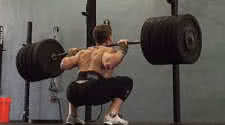Proper Squat Depth in Powerlifting & Bodybuilding - Improving Squats

Building a Foundation Starts with Proper Form and Execution
The rule of thumb for squatting is to descend until your thighs are parallel to the ground. This guideline works
well for the casual lifter, but some bodybuilders will benefit from a deeper squat. Likewise, other bodybuilders
will find that a shallower squat suits them best.
Deep squats (lower-than-parallel thighs, or less than 90 degrees of knee flexion) are popular among power-lifters
and Olympic lifters - the same lifters who can't wear normal pants because their thighs are so massive. Coincidence?
I don't think so. Most likely the muscle development is directly related to the increased range of motion and
muscle activity of the deep squats, not to mention the tremendous amount of weight used. But deep squats aren't a
guarantee of tree-trunk thighs; in fact, they may increase your risk of injury.
No doubt about it, squats place a great deal of stress on the knee joint. Initially the quad muscles pull the
kneecap into the knee joint, providing stability. Yet the compressive forces increase as your body descends,
eventually becoming strong enough to cause joint damage in some individuals (especially when performed on a regular
basis). Unfortunately the point at which the risk of injury outweighs the benefits of increased muscle involvement
varies from one person to the next. The cutoff has been arbitrarily set at 90 degrees of knee flexion.
Body type also determines the depth to which you can squat. Short bodybuilders are able to squat so low their glutes
nearly touch the floor. Tall lifters - those with a longer femur (upper leg bone) - simply have more trouble doing
so. They have a higher center of gravity requiring them to bend excessively at the knees and/or waist to keep their
balance. This puts even more strain on their knees and lower back, opening the door for more serious problems. Most
long-legged lifters are lucky if they can squat to the 90-degree knee position at all.
If you're tall, don't force the issue by performing heavy squats beyond your limits or with bad form. Instead,
limit your downward motion and choose different exercises to sculpt your thighs. Take comfort in the fact that
shallow squats can he performed with heavier weights. Although deep squats have the advantage of building mass
through increased range of motion and muscle-fiber recruitment, shallow squats are safer and will provide good gains
with heavier resistance.
If you're predisposed to knee injury or have a known knee condition, deep squats probably aren't for you. Consider
squatting just to the parallel-thigh position or as low as you can f without knee pain or discomfort. Your body
continually provides feedback, so listen to it.
Immediate knee pain during squats or chronic soreness afterward is a telltale sign of excessive knee strain.
Bodybuilding isn't just about big muscles - it's also about training smart and staying healthy.